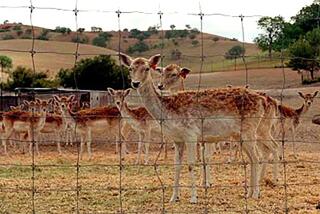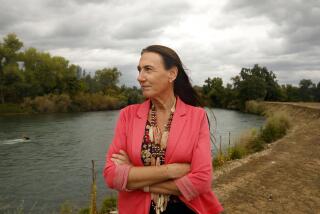Big Country
- Share via
The craggy cliffs, flowing hillsides and pastures are a familiar sight to the nearly 40 million people who travel each year on Interstate 5 through Tejon Ranch property.
What motorists don’t see are the many things that happen on California’s largest privately-owned contiguous land holding: cattle raising, horse breeding, farming, game hunting, mining and dozens of film shoots each year.
Once a large operating ranch, Tejon Ranch Co., which does$19 million a year in business, has expanded into a number of other ventures, including developing part of its 16 miles of freeway frontage along the I-5.
“We have a new president, a new business plan and a board of directors with a new attitude about needing to grow the business,” said spokesman Dennis Mullins.
Real estate development
Tejon Ranch owns 16 miles of frontage along the Golden State Freeway and all commercial land surrounding four interchanges on I-5. Plans include providing more gas, food, lodging and retail services to freeway motorists. More distant plans call for developing a “destination attraction” at the Grapevine and perhaps even a new city for 20,000 people in southern portion of Tejon Ranch, just off Highway 138.
* 78-room Countryside Inn opened last March at the base of the Grapevine in Kern County
* 50-acre truck stop to be completed late this year at Laval Road, the last interchange before the Highway 99-I-5 split.
* An Industrial park planned on adjacent 250 acres.
Farming
Farming is the ranch’s biggest revenue producer, netting $3.1 million in 1996. Nearly 4,000 acres devoted to growing crops, with 600 more acres of almonds planned. Additional land is leased for row crops such as carrots and onions.
Tejon Ranch
Population: Approximately 100 Tejon Ranch employees
Elevation: 700-6,700 feet
Size: 270,000 acres or 420 square miles, roughly the size of the city of Los Angeles
Livestock and Horses
By next year, Tejon Ranch expects to be among the top 10 cattle producer in the country.
* Herd size: 16,700 head, to increase to 22,000
* Custom-fed: Tejon purchased a Midwest feedlot last March to custom feed its cattle.
* Joint venture: Tejon Ranch is working with 12 other top producers and a major meat packer to market top-end meat.
* Horses: 22 quarter horse mares are bred at the ranch. The ranch hosts a horse-cutting competition each May and will add another event in September.
Oils and Minerals
The ranch leases land to two rock quarries and a limestone quarry/cement plant and has about 200 oil wells dating back to the 1930s.
Game Hunting
About 500 people a year pay to hunt wild game at Tejon Ranch. In addition, High Desert Hunt Club leases 8,000 acres for pheasant and quail hunting. Off-season access to the ranch is available for $750.
Timeline:
1772: Captain Pedro Fages, first European to travel across Tejon’s lands, leads troops over Tehachapi Mountains in search of Spanish army deserters.
1829: Explorer Jedediah Smith comes of Tejon Ranch, followed by Kit Carson iin 1830.
1837: Fur trapper Peter Lebec killed by bear on future site of Fort Tejon. Nearby town later named after him.
1843: Three of four ranchos that make up Tejon Ranch is granted by Mexican government.
1854: Fort Tejon established as U.S. Army Dragoon post and terminus of the U.S. Camel Corps which hauled supplies from Texas.
1855: Government Surveyor Edward Fitzgerald Beale acquires Rancho La Liebre in the Antelope Valley, the first of four ranchos that encompass Tejon Ranch. By 1866, he will own all the Tejon Ranch property.
1864: Fort Tejon, now the site of Civil War re-enactments, abandoned after it was evident California wasn’t going Confederate.
1912: Several pioneer families from the San Fernando Valley and Los Angeles, buy the ranch from Beale’s son, Truxton.
1936: Tejon Ranch Co. incorporates.
1939: Ranch owners grant land to state to establish park at Fort Tejon.
1973: Company listed on the American Stock Exchange.
1991: Environmental artist Christo unfurls 1,700 yellow umbrellas in and around Tejon Pass for nearly three weeks in October.
Sources: Tejon Ranch, Standard & Poor’s Stock Reports/Researched by STEPHANIE STASSEL/Los Angeles Times
More to Read
Inside the business of entertainment
The Wide Shot brings you news, analysis and insights on everything from streaming wars to production — and what it all means for the future.
You may occasionally receive promotional content from the Los Angeles Times.










